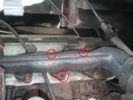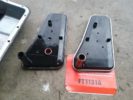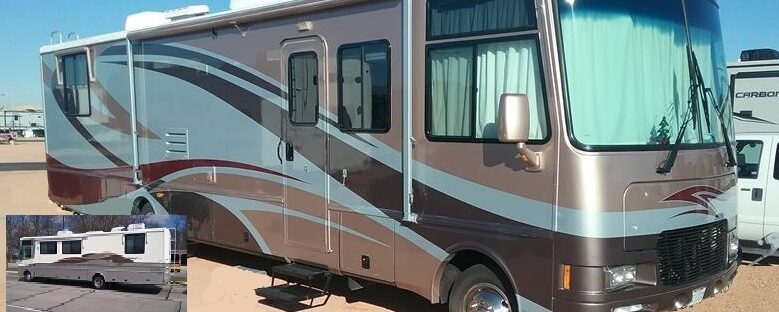UPDATE – Dec 2023 – The pipe that comes out of cylinder #2 cracked and broke when we were 1/2 way between Ohio and Phoenix. Fortunately the break was in a nice straight section of the pipe. I was able to use a 2 inch strap clamp to join the two broken pieces back together, better than new, but will start looking for a Banks system.
UPDATE – Dec 2022 – Been almost 5 years and 30,000 miles.. No issues to report. Oil consumption is level at about 1 qt every3000 miles.
UPDATE – Apr 2021 – We’ve now traveled three years and 17,000 miles since this major work. No issues with headers, valves, etc. After the first year, I re-tightened several of the manifold bolts. The second and third year they were ok. I also noticed improvement in oil consumption. We were burning 1 qt every 1200 miles, this is now 1 qt about every 2500 miles.
March 2019. Anytime I tear into an engine or transmission, I’m always a little nervous on the next major trip. I now have 7500 miles on the exhaust stud repairs and upgrades. Our winter trip took us as far west as Yuma, AZ, We then followed the southern border (I-10) to the east coast (Everglades) , then back home to NW Ohio. During the trip I monitored the systems and observed no problems. In fact, I’m happy to report we observed performance improvements that are a direct result of upgrades.
WHAT TRIGGERED UPGRADES
 What started out as repairing 2 broken exhaust studs escalated into more extensive work, including removing both heads for repair of 12 broken studs. Then instead of re-assembling using the OEM exhaust manifolds, I replaced them with long exhaust headers. (SEE REPAIR BROKEN STUDS)
What started out as repairing 2 broken exhaust studs escalated into more extensive work, including removing both heads for repair of 12 broken studs. Then instead of re-assembling using the OEM exhaust manifolds, I replaced them with long exhaust headers. (SEE REPAIR BROKEN STUDS)
This work also included replacing engine sensors, plugs and COPs, installing heat shields, service the cooling system, replacing the water pump, fan clutch, and installing a high flow thermostat. (SEE FAN CLUTCH)
I also replaced the transmission filter and flushed it with fresh fluid, and replaced an external transmission in-line fluid filter with a new spin on type.(SEE TRANSMISSION FILTER)
QUIETER – REPAIR BROKEN EXHAUST STUDS
Its definitely quieter. Exhaust leaks from the broken studs are no longer there. The long headers improved the exhaust flow, providing a little more power.
MORE POWER
Unfortunately I don’t have a benchmark that gathered hard evidence of power. However, while traveling with cruise control on. within the first 50 miles of travel, I noticed when climbing small inclines like overpasses, it wasn’t downshifting as much as it used to. Now it rarely downshifts even on longer hilly inclines, the downshifts were fewer, or much later in the climb.
BETTER GAS MILEAGE
Last year we averaged 6.75 mpg for the entire trip (5,000 miles), This year we averaged 7.0, same basic routes, same driving conditions, same loads, same weight.
TRANSMISSION:
 I noticed the torque converter seemed to lock up faster after shifting, almost instantaneous, and didn’t unlock with slight accelerator changes. I attribute the locking / unlocking, and faster shifting to the flushing and use of Valvoline ATF Synthetic. The torque converter unlocking may also have been because of a little more power.
I noticed the torque converter seemed to lock up faster after shifting, almost instantaneous, and didn’t unlock with slight accelerator changes. I attribute the locking / unlocking, and faster shifting to the flushing and use of Valvoline ATF Synthetic. The torque converter unlocking may also have been because of a little more power.
I used the Torque App on my android to monitor transmission temperature. It would typically hang around 165 deg, The highest I seen was 180 while struggling through city traffic in Miami with air temperature of 85 deg. Generally, it seemed like the transmission temp was almost always about 100 deg above outside air temperature. I may put a small electric fan in front of the transmission cooler radiator.
I still need to do the bypass tube re-build. And also not sure if I will upgrade the cooling system radiator. (Early model F53 did not incorporate transmission cooler into radiator)
ENGINE TEMPERATURE
 Last year I had a couple occasions where I seen the temperature gauge climb to about 3/4 while making some slow hard climbs.
Last year I had a couple occasions where I seen the temperature gauge climb to about 3/4 while making some slow hard climbs.
I installed a new water pump, fan clutch, and a high flow thermostat. During this trip, I never seen the temperature move off of the 1/3 mark. I did notice the fan clutch engaging a lot more than it did last year, on hard climbs and especially when it was warm and we had a strong tail wind.
EGR DELETE
Because the headers I installed did not have an EGR port, I deleted the EGR valve on the intake manifold and spoofed the differential pressure sensor by re-arranging the vacuum lines. No codes were set during the trip so the spoof must have worked. There was initial concern that the EGR delete may contribute to pinging and possibly lower mileage. After researching, I found that normally, the EGR recirculate is only commanded at low power throttle settings. Low power throttle settings are extremely rare in my motorhome.
CONCLUSIONS
I’m happy with all the work and resulting performance. I have a good, reliable drive train, and a good coach with the systems we like. This is a keeper, we have no intentions of buying a new coach.
Before our western snowbird excursion next winter, I’ll be doing some minor maintenance this summer:
- Repack front wheel bearings, install new seals. (DONE)
- Replace all brake pads. They appear good, but I’m not sure about the age. (DONE) I replaced all the brake hoses last year and flushed the lines. (SEE BRAKE HOSES)
- Drain differential and re-fill with fresh oil. Lucas has 75w140 synthetic for $42 a gallon, I need three gallons. (DONE)
- Redo the CHF on the front. Replace the extended links with OEM links. The shorter links should give better anti sway performance. (DONE)
- Replace torsion bar bushings, front and rear. (DONE)
- Replace the speed sensor on the rear differential. (DONE)
- Look at possible install of rear track bar on the rear differential. (DONE)
- Rebuild the transmission bypass tube. the internal relief valve gets overhauled to make sure its not leaking. (DONE)
This will bring all the maintenance up to date and a known condition.
Safe travels..

Pingback: F53 Repairing broken exhaust manifold studs – 1999 Southwind 35S
Where is the obdII port? My check engine light has been on for at least the last year. 60 seconds after every cold start the engine stumbles for about ten seconds then idles fine. Occasionally during acceleration my v10 rattles like a diesel (runs fine at that time) and snaps out of it after a few minutes. It’s a 1999 southwind 35S F53, 78k miles, we have owned it for 4 years. Always liked the motorhome but after a few suspension and electrical upgrades suggested from your site it’s a whole new camper! Thanks for sharing.
It may have a cover on it that makes it hard to see. It should be mounted on/near the steering column. I bought a 1 ft extension and mine now hangs down where its a lot easier to get to.
With 78k miles. if the plugs and cops have never been changed, I’d say thats a good place to start. Use ONLY Autolite APP-103 plugs. They need to be torqued to 23-25 ft lbs. I installed 10 new COPs, and saved the old ones as spares. I bought mine on e-bay, 10 for less than $50.
https://www.ebay.com/itm/10Pack-RED-IGNITION-COIL-FOR-FORD-F150-250-350-4-6L-5-4-V8-V10-DG508-FD503-DG491/162867125213
..
I have a 2000 HR Vacationer built on a ’99 F53 Chassis w 85,000 mls so plugs are due for replacement soon. I understand older V10’s 2 valve aluminum Heads had Spark Plug thread engagement issues and it is easy to strip them out either removing them (carbon build up) or being heavy handed on the torque. Where did you get your spec of 23-25 ft/lbs ?
The problem isn’t heavy handed torque, its just the opposite, not enough torque, the plugs loosen, then when they start wiggling, they eat the thread and pop out. 23-25 ft lbs comes from the numerous postings and test on the Ford Truck Enthusiast forums.